Disclosure: My website is reader supported. If you purchase a product after clicking a link, I may receive a commission, at no extra cost to you. Learn more.
Overview
I used the Adamson B10 bed cooling system every night for a whole month (see it in action in my video above). The cooling was better than I expected, and I slept reasonably well with it. In my temperature tests, it was clearly cooler than my memory foam mattress topper.
However, there were several key points that frustrated me about the Adamson. The need to place it on my bedside table, the noise it makes, and having to be very careful with how much water you add to avoid overflows were the main issues.
Ultimately, I wanted to see if a lower cost bed cooling system like this would be a viable alternative for those without the budget for one of the more advanced bed cooling systems. While it might be effective enough if your bedroom doesn’t get too hot, it’s no match for the more powerful cooling of the Eight Sleep or Dock Pro.
Pros
- Moderate cooling during the whole night.
- Iow cost.
- Lightweight.
- Easy to use with buttons on the unit and remote control.
- No Wi-Fi or Bluetooth connection.
- Low power consumption.
- Auto-off timers.
Cons
- Large device that needs to be on a bedside table.
- No target temperature control.
- Struggles in hot bedrooms.
- Noisy with the fan on (okay with just the water pump).
- Leaks if you add too much water.
- Reservoir needs regular refills.
- The pad is comfortable, but it bunches up.
- Fiddly to set up and clean.
- Drain plug and tubes don’t have locks.
- Some parts are low quality.
Price
The price fluctuates since it’s sold on Amazon. It typically costs around £240 in the UK, $200 in the US, $200 in Canada, and €200 in Europe.
You can find it here on Amazon.
Full review / video transcript
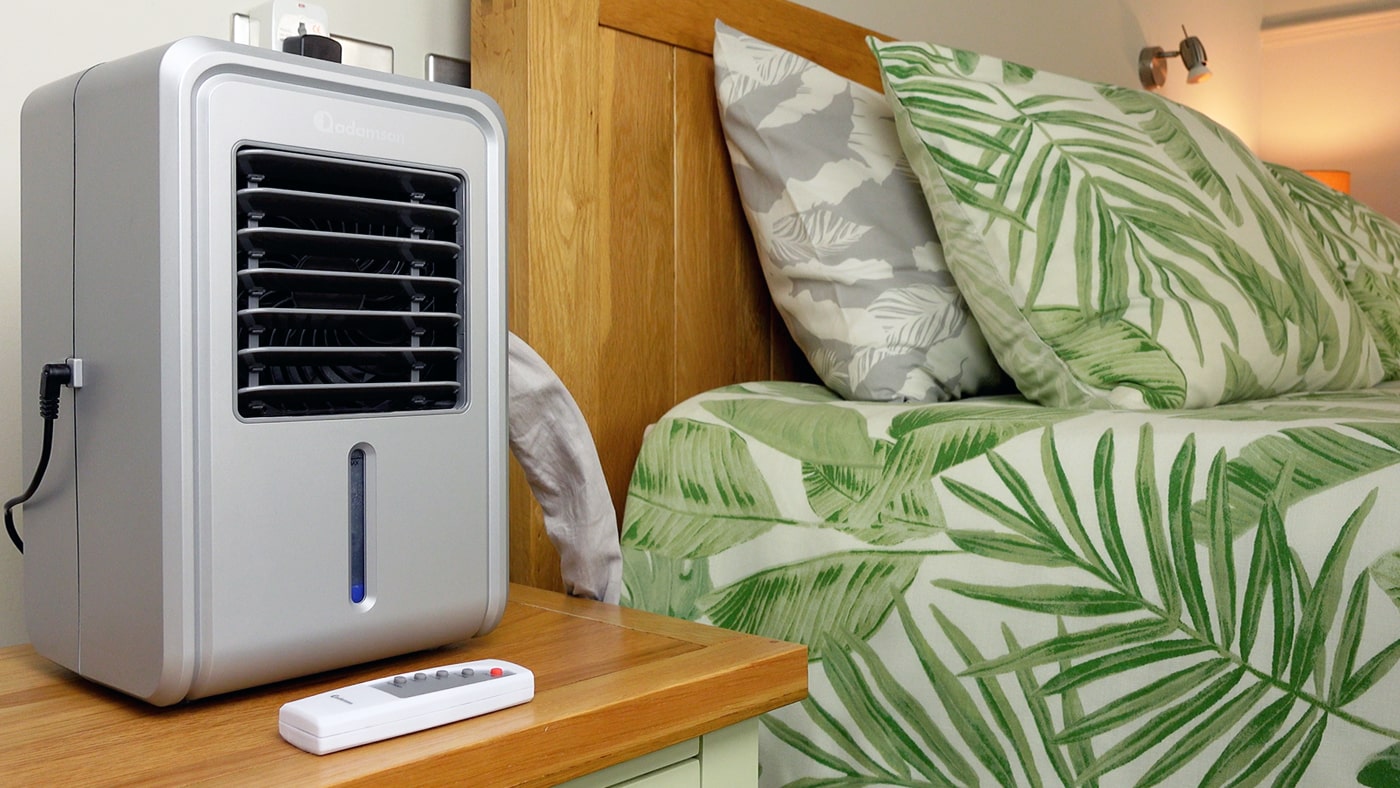
Introduction
A month ago, I bought the Adamson B10 bed cooling system for £243 in the UK, and I’ve used it every night since. I have to admit though, I was a bit nervous about this one at first.
Some design choices baffled me. And even the manual warns you to put the cooling unit inside a basin when you set it up due to the risk of overflows, which doesn’t exactly inspire confidence.
On the plus side, it’s far less expensive than other bed cooling systems I’ve used, such as the Eight Sleep Pod, the Dock Pro, and the BedJet 3.
The Eight Sleep Pod 5, for example, which I also just bought and will review later this year, currently costs around 10 times more.
In the photo below, you can see the useful remote control. There are buttons on the cooling itself as well.
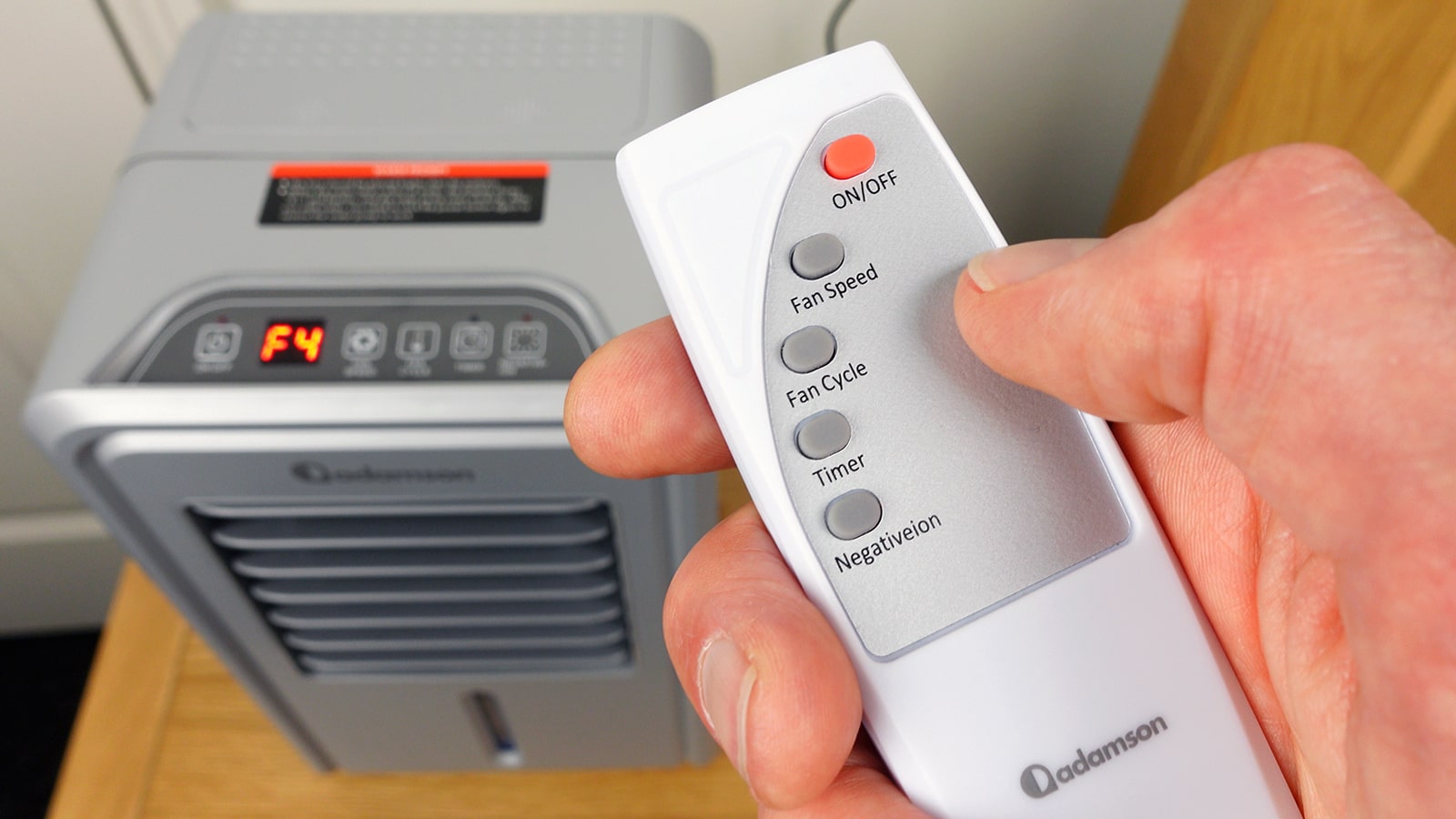
Price comparison
| Price (USD) | Price (GBP) | |
|---|---|---|
| Eight Sleep Pod 5 Core | $2849 – $3249 | £2449 – £2949 |
| Chilipad Dock Pro | $1199 – $2499 | Unavailable |
| BedJet 3 | $699 – $1629 | £499 – £1109 |
| Adamson B10 | $182 | £243 |
I looked up the prices in the table above in June, 2025. They do not include any sales. Those with a price range depend on the mattress size and whether you want single or dual zones.
I really wanted the Adamson B10 to be good. Not everyone whose sleep is affected by heat can afford one of the higher end devices. So I wanted to be able to share a lower cost alternative.
That’s the main reason I decided to use this one in between using the Dock Pro, which I’ve been missing, and the Eight Sleep Pod 5, when it finally arrives. I also think it’s useful for reviewers to have experience of a range of cooling options.
Below, I’ve set up the BedJet 3, Adamson B10, Chilipad Dock Pro, and Eight Sleep Pod 3 in my bedroom so you can compare the size and design. The BedJet 3 and Dock Pro fit nicely under my bed frame. The Eight Sleep Pod needs to sit next to it. The Adamson needs to go on the bedside table or nearby shelf.

As a very quick overview, it does work – just not as well as the more advanced bed cooling systems. But the evaporative cooling system actually did a better job than I was expecting. However, for me, there are some very obvious dealbreakers.
To illustrate some of the issues, let’s go back in time and take a look at the setup process.
What’s in the box
The Adamson arrived in just one small box, containing the mattress pad, the main cooling unit, and a few other parts.
There’s a useful remote control with batteries included. A water loop piece to turn it into a humidifier, and a tiny spare drain plug which my hoover would love to gobble up! It comes with a DC power adaptor, which annoyingly has an American plug, so I have to use a UK adaptor. And there’s a mostly easy to follow user manual.
I was surprised by how light both the pad and cooling unit are. However, one reason it’s so light is because the plastic casing isn’t very solid.
Below, you can see the US power adaptor it comes with. I really wish electronic devices sold on Amazon actually came with the correct plug for the country you buy it in!

Set up
To set it up, I started with a waterproof mattress protector, just to be on the safe side.
I then unrolled the mattress pad onto my side of the bed. It’s only made in a twin size of 79 x 35 inches. So unfortunately, that means it’s wider than half of my UK king size bed.
You can put it sideways for two people to share. But Irene doesn’t like cooling, so I later hung the excess over my side as there are no water tubes in the first few inches anyway.
There are actually two elastic straps to keep it in place on a mattress, a useful feature I somehow missed when filming the set up…
Below, you can see how the pad that contains the water is much wider than my half of the bed. You can also see that the water tubes are not very long, so the unit can’t be too far away from your bed.
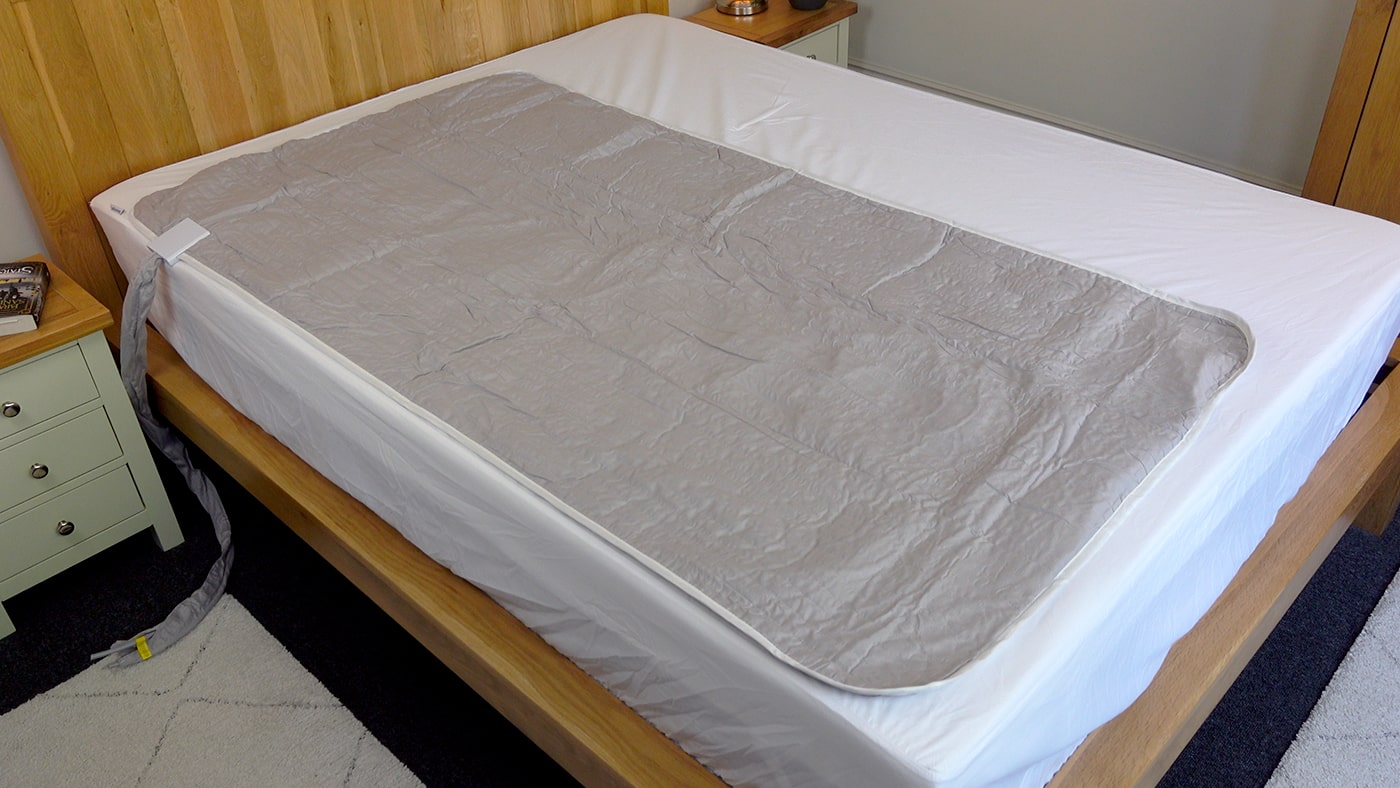
The two water tubes connect to the pad inside a fixed plastic encasement. It’s another good reason to hang the pad over the edge, otherwise you‘ll feel the solid case in the night.
Because my bedside table is lower than the top of the mattress, I had to do the alternative setup. For that, they recommend putting the cooling unit in a basin at first in case there’s an overflow.
The intake and outtake water tubes are very thin, with some loose fabric around them. I was very unimpressed by the low-quality stitching and fit of this material.
Below, I’m attempting to attach the water tubes to the main cooling unit. If you have finger sensitivity issues or lack hand strength, this will be a struggle.
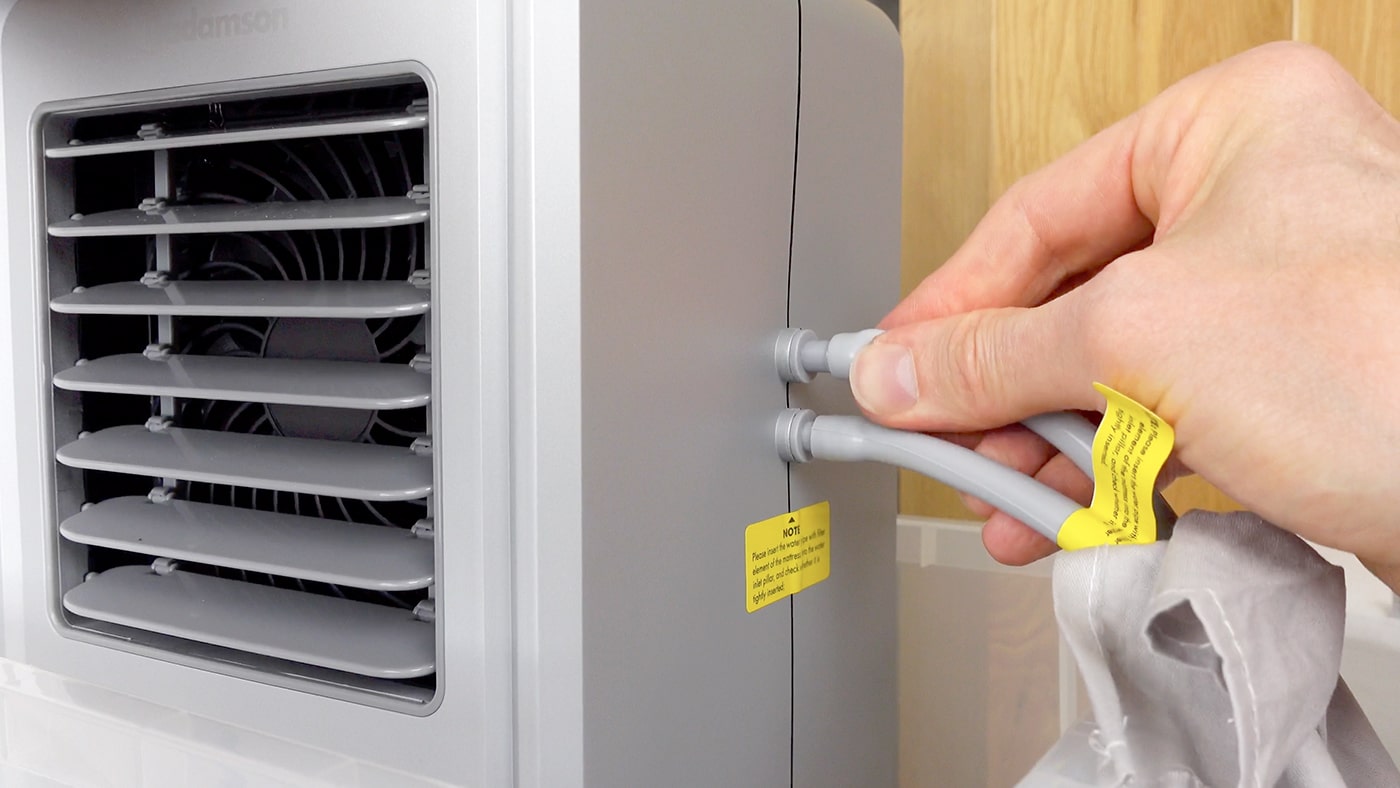
Connecting the tubes to the control unit was surprisingly difficult. I had to use a lot of twisting and force, and I was worried I was going to crush the entire unit in a Hulk moment!
Eventually I got them on, but it would be far better to have a locking mechanism like the Eight Sleep or Dock Pro have.
I then used a kitchen tie to tidy up the fabric. Still not pretty, but better. All in all, it felt more like assembling Lego than modern tech…
The next step was to slowly fill the water reservoir with 2 liters, or half a gallon of water. After that, plug it in and turn it on to pump the water into the pad. Then you add more water until you reach the three-quarters level on the indicator.
The confusing part, however, is that if the bottom of the unit is lower than the top of your mattress, like mine, you’re only supposed to half fill the water tank.
The instructions then say that 1 of 3 scenarios will play out. Scenario 2 is that it overflows into the basin and you should fill less than half the next day. Fortunately, scenario 3 played out for me and nothing went wrong.
Criticism of the setup
Even though mine didn’t overflow, which was a relief, there are still points about the design and setup that bother me.
First of all, surely it would be better to quarter fill the reservoir to start with and then if it doesn’t overflow, but doesn’t last all night, then maybe add half the next time.
Or better still, don’t design it in such a way that it’s so easy to accidentally add too much water and then have an overflow that goes through the unit. The manual says that the electronic components of the unit are water-resistant, which you would hope, but not designed to be submerged.
So for me, the need to place it high up and the risk of overflows are probably the two biggest dealbreakers. I’d prefer not to have something this size on my bedside table.
And I can’t help but feel concerned by the potential for leaks, both over my bedside table and over electrical components. Call me paranoid, but something feels a bit off about that design.
The need to be placed high up & how it works
Why can’t it sit at floor level, or better still, underneath my bed frame? I imagine one reason is that the pump isn’t strong enough, so they’ve enlisted the cheap labour of gravity to help the water circulate and to stop it draining out of the pad and into the unit when it’s turned off.
It’s also important to understand that it’s not a closed water system and that leads into how it works. The Adamson doesn’t actually actively cool the water to a set temperature.
What it does is cycle the water in the mattress pad that’s heated by your body back into the unit. It then passes through a cardboard filter and is exposed to the air and the fan so some evaporative cooling can take place.
That’s also why they recommend keeping your bedroom temperature below 76°F (25°C) for optimal performance.
How effective is the cooling? Some temperature tests
How well does that evaporative cooling system actually work? Well, as I said at the start, better than expected.
The manual says it can cool the mattress by 6–12°F (3–7°C). To test that, on two different mornings I used my infrared thermometer gun to measure the temperature of the mattress pad where my upper body had been – one day with the pad, and the next day without it.
It’s not a precise measurement, but you can see that it roughly demonstrates a difference of a few degrees Celsius. Sorry about the shaky camera and dark image by the way, I literally rolled out of bed at 6 a.m. to quickly film this!
In another test, I lay on each side of the bed for one hour without moving. Even from a distance, which is less accurate, you can see that the pad is a couple of degrees cooler than my memory foam mattress topper.
Below, you can see a snapshot of the temperature I recorded after lying on each side the bed.
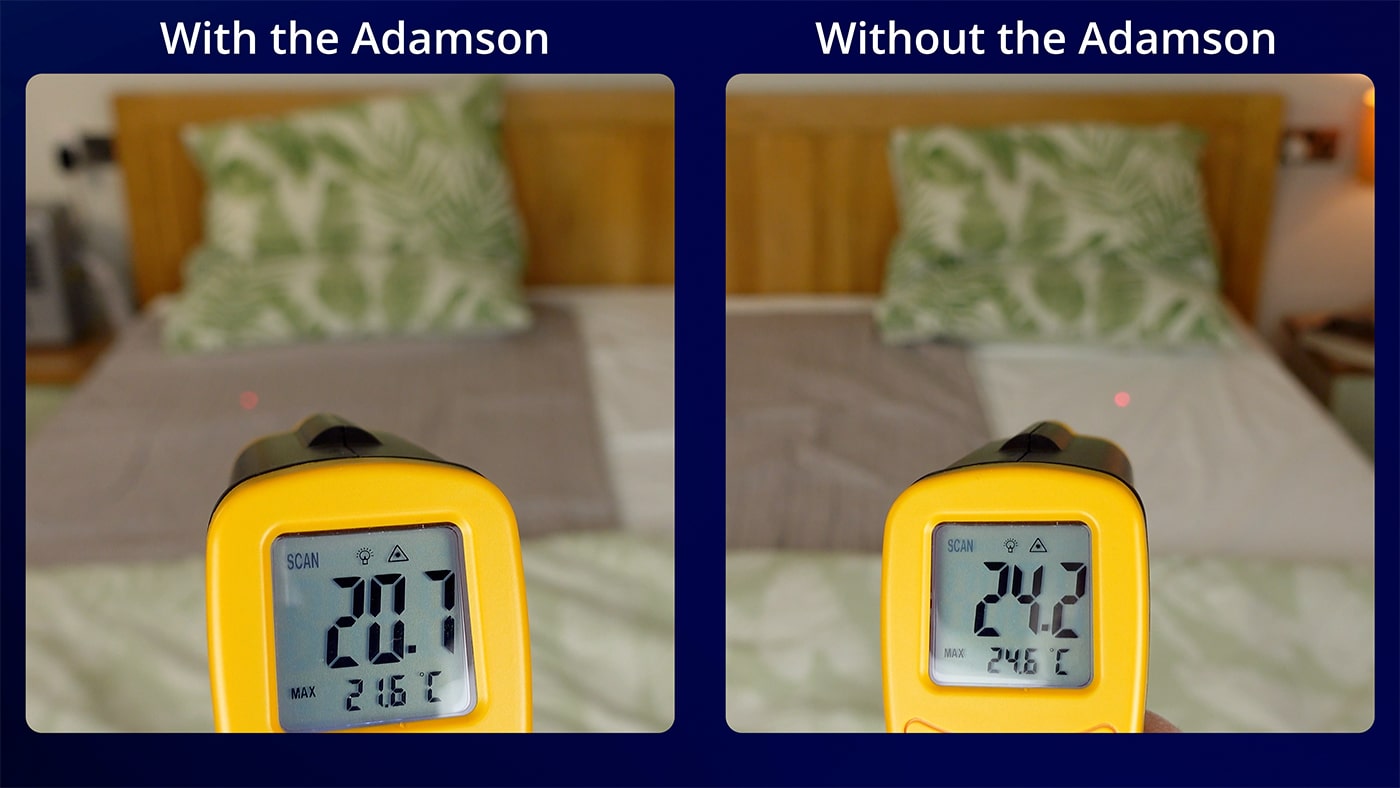
And that does reflect what it’s been like to actually use, in my admittedly relatively cool bedroom. Sleeping on the pad is definitely cooler than lying directly on memory foam. And importantly, it seems to work throughout the whole night.
It’s not as cool as the Eight Sleep or Dock Pro though, which can get much colder as they actively cool the water. And the temperature of the bedroom has far less impact on them as well.
How comfortable the mattress pad is to lie on
As for how comfortable the pad is to lie on, I like how the cover is made from soft cotton. In fact, I’d say it’s more comfortable to lie on than the Eight Sleep Pod 3 or Dock Pro pad were. The Eight Sleep pad was firmer, and the Dock Pro was rougher.
Below, I’ve got two of the silicon tubes between my fingers so you can see how wide they are inside the fabric. Because the fabric and tubes are so soft and flexible, it’s quite a comfortable pad to lie on.
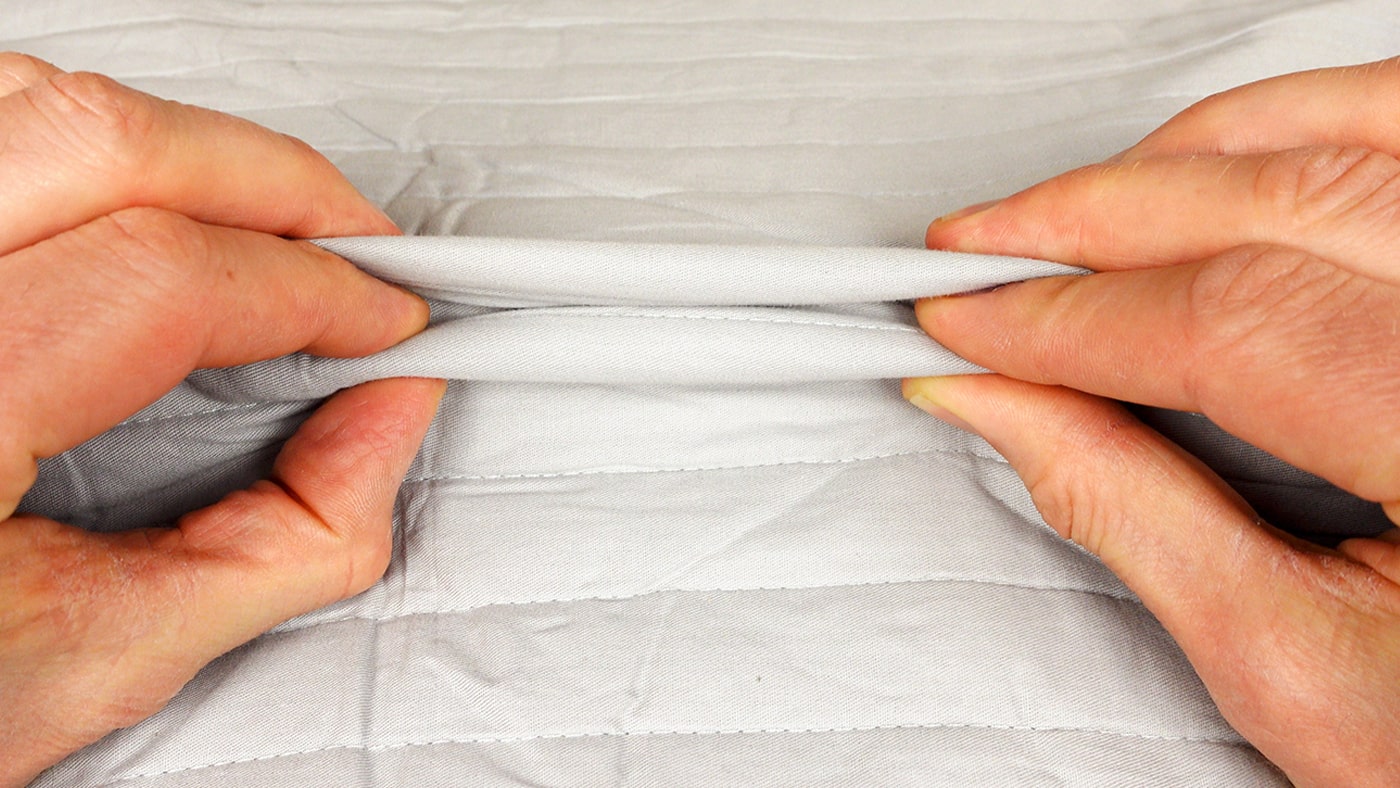
You can feel the silicon tubes if you go hunting for them, but I don’t notice them when I’m in bed. The main problem though is that the pad can bunch up in the night, so most mornings I have to lift my bed sheet to reposition it, which is just a bit annoying.
Fan speed and cooling controls
Let’s look at the controls now, which are exactly the same on the remote control and on top of the unit. It’s important to understand that you can’t choose a specific temperature. Instead, there are some options to control the fan speed.
There are four fan speed levels for the fan, with the fastest fan speed cooling the water most.
In the photo below, you can see all five buttons, which are repeated on the remote control. There are no other controls or switches – it’s just the on/off, fan speed, fan cycle, timer, and negative ion buttons. I found it’s very easy to use once you’ve set it up.

There’s also a fan cycle adjustment button. D1 keeps the fan on. D2 and D3 turn the fan on and off every few minutes, which the manual says is useful if you feel too cold. But I found the change in noise very annoying. And D4 turns the fan off, leaving just the water pump running, which I do like.
Noise levels & measurements
The thing is, it’s really noisy on the fastest fan speed settings. I’m able to block it out with earplugs, but Irene hates the noise and she’s been calling it the tractor recently. So we’ve been sleeping with the fan off. That means less cooling, but it’s been enough to keep me feeling comfortable and I’ve actually slept quite well on it.
Below, I’m measuring the noise of the combined fan and water pump with my sound level meter. Thankfully, it’s much quieter with the fan off and just the pump running, and does still provide some level of cooling!

To give you an idea, here’s a recording of my room noise, and then the fan sounds. It takes my ambient room noise from just over 30 dBA to just over 50 dBA. Only the BedJet 3 on the maximum settings was louder, while the Eight Sleep and Dock Pro were both quieter.
Noise level comparison between devices
In the table below, you can see how four different bed cooling systems and a basic desk fan compare in noise levels.
This is a comparison that could easily be manipulated to make one seem quieter or louder by choosing different settings, so I’ve included some different settings to demonstrate how they vary. They run from the quietest at the top to the loudest at the bottom.
| Device | Setting |
|---|---|
| Eight Sleep Pod 3 (quietest) | Low cooling |
| Bedjet 3 | 25% fan speed + max cooling |
| Eight Sleep Pod 3 | Max cooling |
| Adamson B10 | Fan off. Water pump on. |
| 1 x Chilipad Dock Pro | All temperatures |
| 2 x Chilipad Dock Pro | All temperatures |
| Adamson B10 | Fan on max speed |
| Desk fan | High speed (3 of 3) |
| Bedjet 3 (loudest) | 100% fan speed + max cooling |
Other features
There are a few other features to mention:
Humidifier feature
Firstly, you can use the water loop system piece to turn it into a humidifier. I haven’t bothered with that because I want cooling, not a more humid bedroom.
Below, I’ve removed the tubes that go into the mattress pad and attached the water loop piece. This then converts it into a humidifier. I don’t use it as my bedroom is humid enough already, but maybe it would be useful if you live somewhere dry. But then you wouldn’t have the bed cooling, so it would just be a very expensive humidifier!

Auto-off timers
Secondly, there’s a useful auto-off timer. This is the only programmable feature as there’s no app with scheduling like you get with the Eight Sleep, Dock Pro, or BedJet. The manual says you can set the timer from 0 to 24 hours, but I’ve only been able to make mine go up to 12. Still, having a timer is great.
Negative ion feature
Finally, the negative ion function. I don’t use it and I’m a bit skeptical a device like this can affect your mood or sleep in the same way that natural settings can.
Bright LEDs
The red LEDs are very bright, so I always cover them at night. I haven’t found any way to turn them off, which would be a user-friendly feature in a future model.
Low power consumption
One of the best points about the Adamson is the incredibly low power consumption. The rated power in the specs is 8 watts, so it’s very cheap to run.
I left mine on for 12 hours on the max fan speed with nobody in bed and it didn’t even register one pence on my power meter.
When I then ran it for 24 hours, with me in bed with the fan off for 8 of those, it came to two pence. So on that front, it’s very cost effective to run.
Maintenance requirements and my experience cleaning it
As for the maintenance requirements, it’s quite similar to the Dock Pro in that you have to regularly drain both the unit and the pad. However, you have to do it every two weeks ideally, which is even more frequent than the Dock Pro, and it is a bit of hassle.
Firstly, getting the tubes on and off is frustratingly slow. Draining the cooling unit was very easy because it’s so light, which is good. But this was when I discovered another mini deal breaker. The drain plug is just a tiny piece that sticks into the bottom of the unit. There’s no locking mechanism. And that makes me wonder how robust it will be in the long term.
Below, you can see the tiny drain plug and underside of the cooling unit that it sticks into. If you remove it (or it leaks) the entire reservoir will drain out. You do get a spare one, but I’m not entirely sure at what point you should swap them.
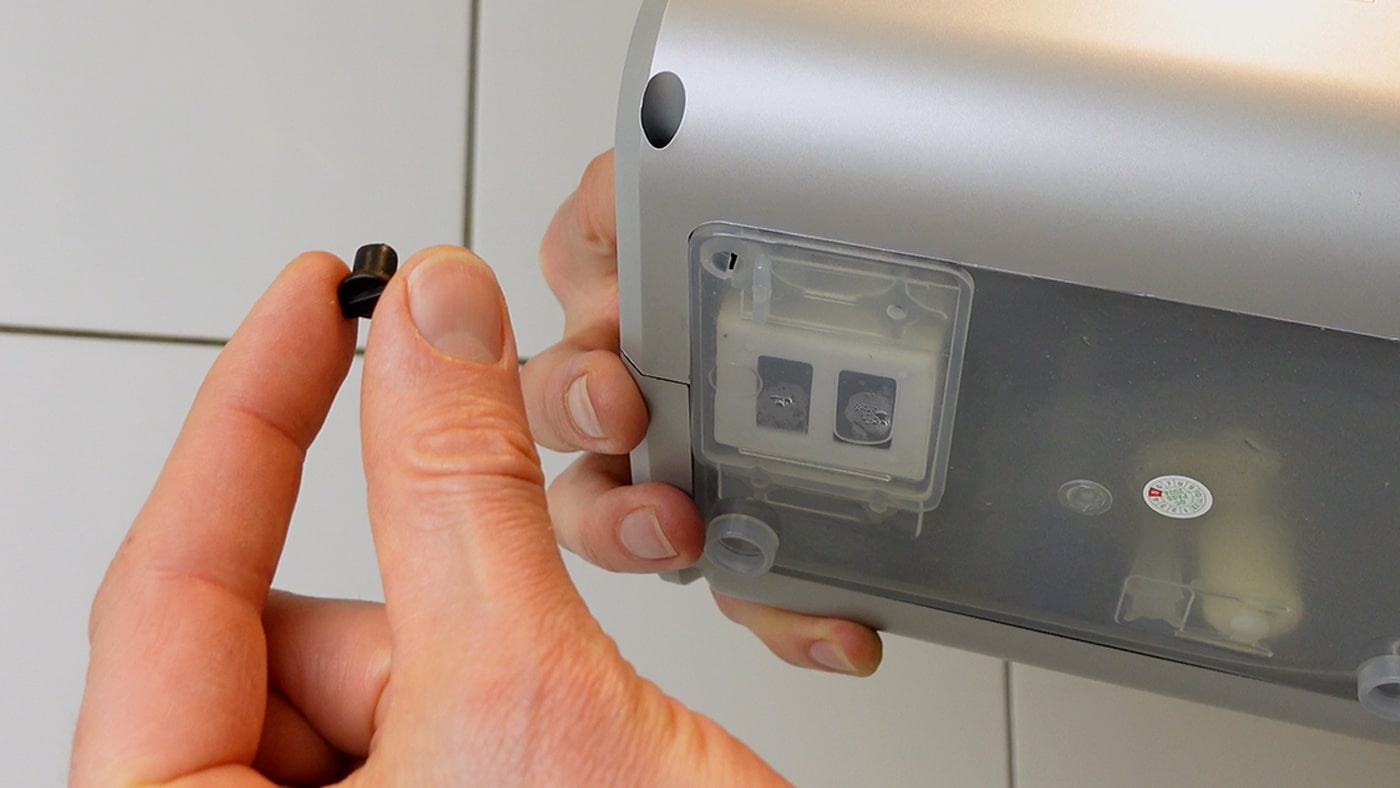
Draining the pad was a bit trickier because of the length of the tubes. You’re meant to hang it up and leave it to drain and dry, but I just held mine over the bathtub.
The mystery part was to wipe the honeycomb cardboard filter panel before putting it back in place. I interpreted that as removing the filter, but you can’t easily open up the unit.
I messaged their support about this who told me I should only wipe down the exterior and not open it up. So I think the maintenance instructions could be improved. You can also add bleach once a month, but I haven’t done that yet.
Below, you can see the green cardboard filter inside the Adamson B10. You’re not supposed to access it according to their support response, even though the manual makes it seem like you do remove this part. Because the plastic casing is so soft, I dented it in places with my screwdriver when opening it. They told me it might void the warranty if you open it up, and I imagine the minor damage to the plastic is one reason. It is interesting to see the way the water slowly cascades through the filter though!
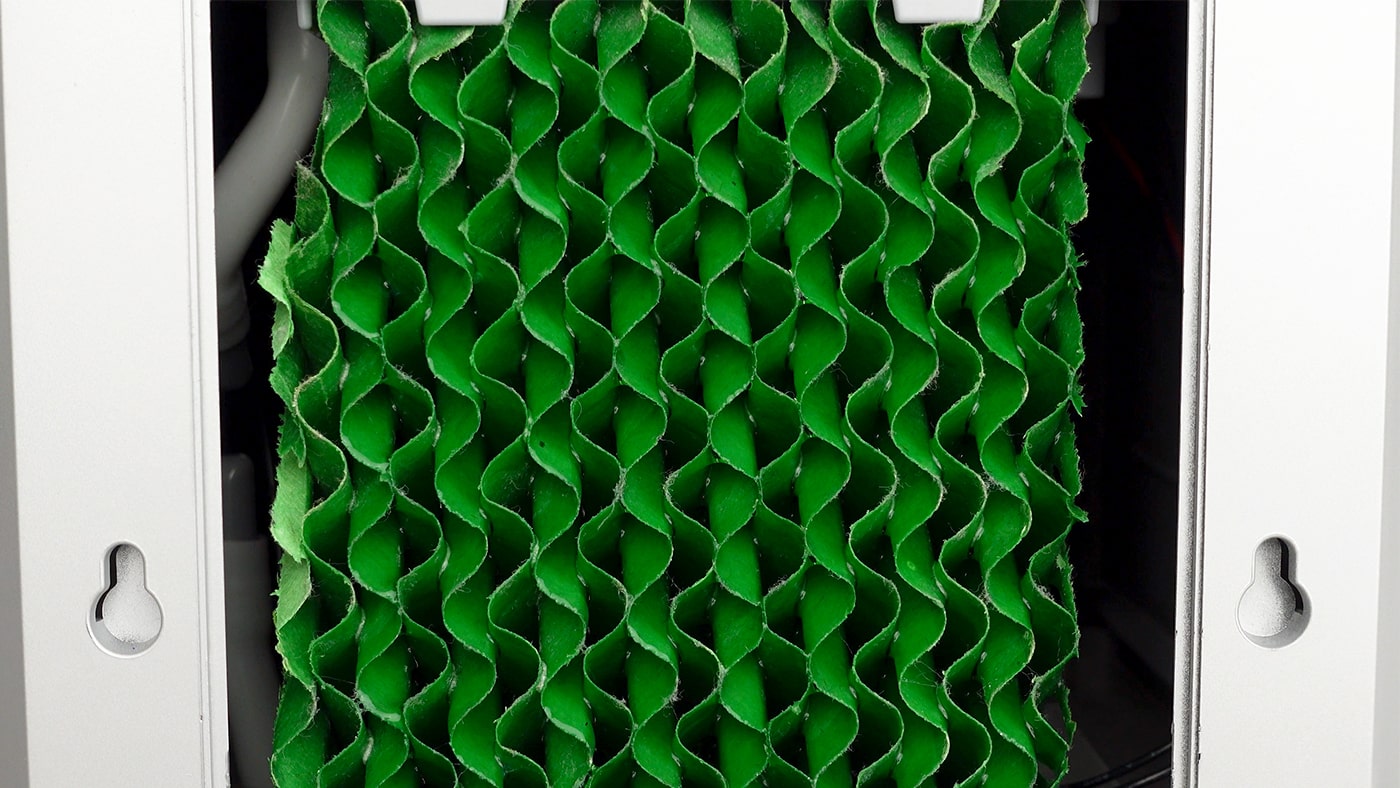
Pros and cons recap
Before I give you my verdict, let’s recap with the main pros and cons.
Pros
- It provides moderate cooling during the whole night.
- It’s relatively affordable, with no subscription fees.
- It’s lightweight.
- It’s easy to use with buttons on the unit and remote control.
- There’s no Wi-Fi or Bluetooth connection, if that’s something you worry about.
- The energy usage is very low.
Cons
As for the cons, and this is going to take a bit longer:
- It’s a large device that needs to be on a bedside table or shelf.
- You can’t set specific target temperatures.
- It doesn’t work as well in hot bedrooms.
- It’s noisy with the fan on, but ok with just the water pump.
- It will leak if you add too much water, with the water running through the unit.
- Since water evaporates, the reservoir needs daily refills.
- The pad is comfortable, but it bunches up.
- It’s fiddly to set up and clean.
- The drain plug and tube connection points don’t have locking mechanisms.
- It feels flimsy and cheaply made in places.
Extra note about water reservoir refills
I don’t go into much detail about how much water it uses in the video. I’d like to say it’s because it’s not important, but I actually completely forgot to cover it in more detail!
What I’ve found is that I need to top up the reservoir every morning if I use the fan on the faster speeds. But since I’ve been using it with the fan off and just the water pump on (D4 on the fan cycle adjustment control), it seems to last 3-4 days without needing a refill.
However, when it gets hotter where I live, the water will likely evaporate more quickly. So I think it’s hard to predict exactly how often you’d need to refill it.
Verdict
My final verdict then is that the Adamson B10 bed cooling system is capable of providing some gentle cooling, but it failed to impress me in several key areas.
Perhaps I’m hard to impress because I’ve spent years using the Eight Sleep, the Chilipad Dock Pro, and the Bedjet 3.
But even if I hadn’t, I still think I’d be concerned by the potential for leaks, the noise, the space it occupies on my bedside table, and the quality of some parts and connection points.
Now if you disagree and you’re willing to tolerate the various issues I’ve mentioned to get a lower cost bed cooling system, then just keep a close eye on the returns window, and an even closer eye on the water level indicator when you’re filling it.
And finally, I’d be very interested to hear from you if you’ve also tried the Adamson or any other lower cost bed cooling system. There are a few others sold online that I haven’t had a chance to try, for example, so I’d love to hear from you if you have tried them.
And if you have any questions or thoughts about the way the Adamson works, let me know in the comments below. It’s always good to hear from you.
Thanks for watching/reading this one.
Sleep well.

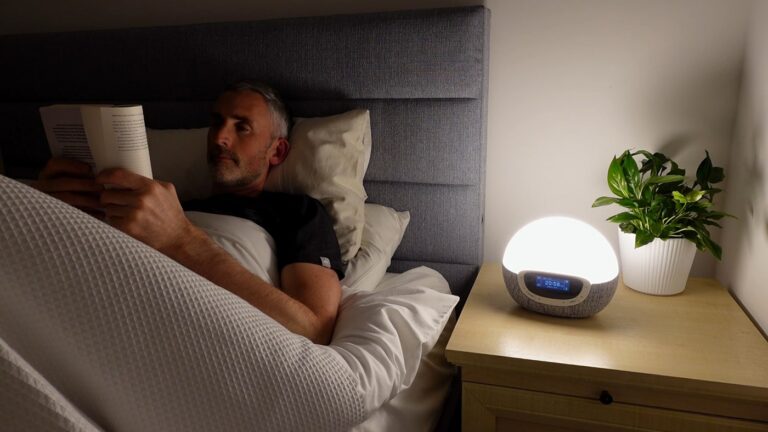
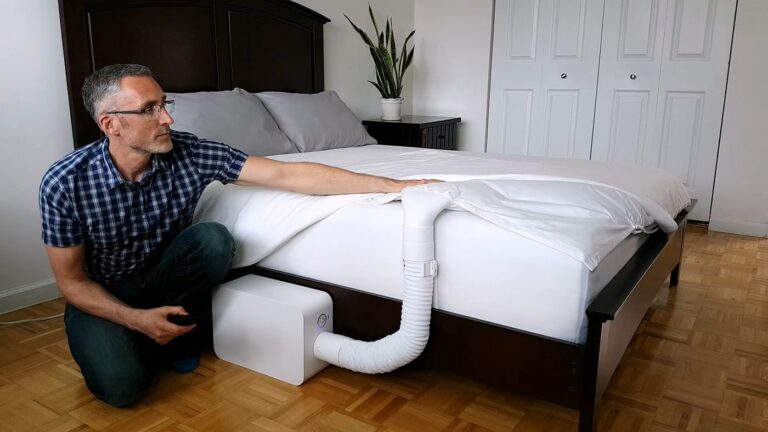
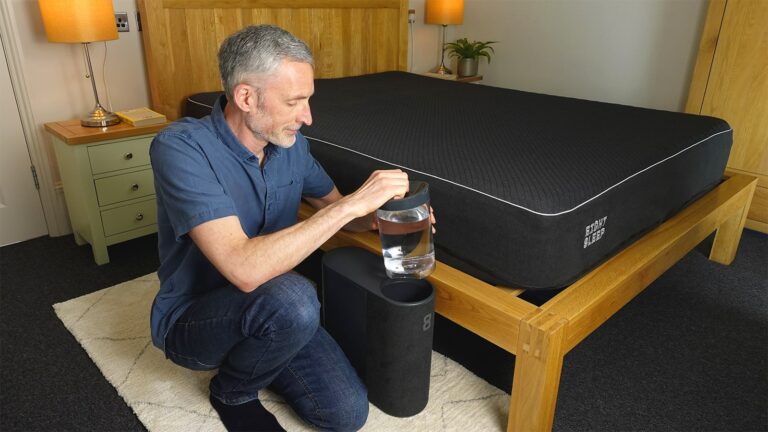
I have one and I put very cold water in it. I never feel it. When I first got it it worked great. 2 months later, nothing but warm water. It’s a piece of $%^&.
Hi Susan
Thanks for your comment. Did you manage to get a refund, or was it not possible after two months?
Your idea of adding very cold water is good though, I never thought of that.
Regards
Ethan